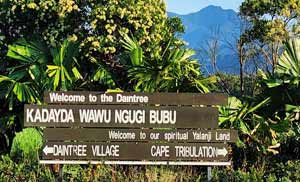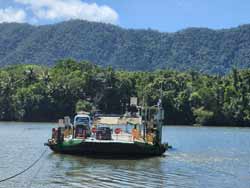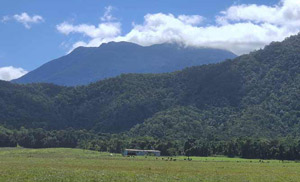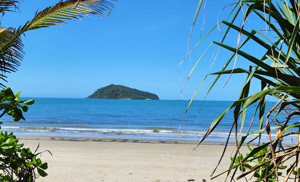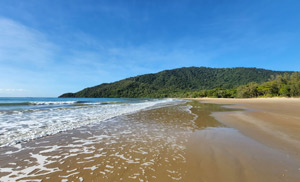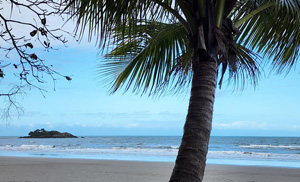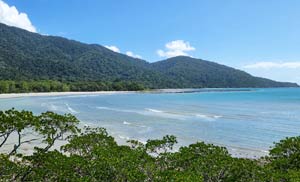Daintree Coast History
A snapshot of Daintree Coast history
Daintree Coast historical timeline
Some interesting historical facts about the Daintree Coast.
Prior to European Settlement
The Daintree region was originally home to the aboriginal people of the Kuku Yalanji tribe, who lived in small camps along the banks of creeks and rivers.
1770
Captain James Cook named Cape Tribulation. 'Here began all our troubles'. His barque, Endeavour, struck the Great Barrier Reef and they limped in to Cooktown to make repairs.
1873
George Dalrymple 'discovered' the Daintree River and named it after a former Queensland Government geologist, Richard Daintree, who was then Queensland's Agent-General in London.
Oddly, Richard Daintree never visited this area but his geological surveys helped open up many coal and gold mines in later years.
1877
The discovery of gold changed everything for the rainforest Aboriginal people, violent clashes with European settlers often resulted in fatalities.
1879
The first permanent settlers in the Daintree Village area were the Stewart brothers.
1883
Daintree Village was established on the Daintree River, which was the only way of access until 1933 when the road to Mossman was completed. Supplies and mail arrived once a week from Port Douglas and produce and passengers left on the return journey.
Daintree Village was first a base for the red cedar timber industry and in the old logging days the logs were floated down river and loaded onto small coasters at Daintree Heads.
Later European and Chinese settlers on both sides of the Daintree River tried many crops – sugar-cane, coffee and other crops but floods, disease and marketing proved major stumbling-blocks.
1900
The two half-time schools at Cow Bay and Daintree Village closed due to the resignation of the teacher who, each week, had to row 16 miles between the schools, 4 of them in the open sea along the coast.
1911
A cyclone razed Port Douglas and surrounding countryside, two people were killed.
1924
Daintree State School opened in Daintree Village with 10 pupils.
A butter factory and sawmill were built, both running on the same steam boiler – the caravan park now occupies the site.
The Village had a store, post office, drapery, butcher, baker, cafe, blacksmith and sawmill office.
1929
Barratts Creek Bridge opened – before that it was a 6-8 hour horse-ride from Daintree Village to Mossman and the creek could only be crossed at low tide.
1932
The Mason family were the first white settlers of Cape Tribulation. Walter Mason reported that more than 300 Aborigines lived along this coast in small family units.
1933
Completion of the road from Mossman to Daintree Village.
1937
There were six settlers and their children at Cape Tribulation. A parcel of meat arrived weekly on the Cairns-Cooktown boat.
1942
During World War 2 a Japanese aircraft dropped 8 bombs in the region, one landing along Bamboo Creek Road, near Miallo and the Whyanbeel Valley. There is a stone memorial with a plaque stating:-
"At 3.30 am on 31st July 1942 a Japanese aircraft dropped eight bombs in this Shire, one landing 50 metres directly behind this point. Carmel Zullo, aged 2 1/2 years was asleep in the home of her parents when the bomb exploded nearby. Shrapnel pierced the iron walls of the house, one fragment grazing Carmel's skull.”
She was the only civilian casualty inflicted by the enemy on the Eastern Australian mainland throughout World War 2.
1954
A steel punt was used as a ferry to cart timber trucks from the timber mill north of the Daintree River to the south side.
1958
The Douglas Shire Council built an outboard-driven ferry to service residents north of the Daintree River – this was eventually replaced by a new privately-owned ferry.
1962
The Daintree Ferry to Cape Tribulation Road was opened by Andrew Mason.
1966
Electricity was turned on in Daintree Village, South of the river. Daintree National Park was declared by the Queensland State Government.
1968
Local farmers and the community wanted to open a cattle track from Cape Tribulation to Bloomfield. A Dutch-born Cape Tribulation local called Rykers refused permission for it to go through his property so a track was constructed from Bloomfield to a spot just north of Cape Tribulation.
Cattle had to walk along the Cape Tribulation beach then up a steep hill to join the Track. Both cattle and vehicles traversed this “Pioneer's Track” and it became a hiking trail for experience-seekers and nature-lovers, helping promote the area's wilderness values.
1978
The Nicholas family established a tea plantation (now called Daintree Tea) at Diwan, from seed from the Nerada plantation at Innisfail.
1981
The Great Barrier Reef was inscribed onto the World Heritage List for its unique natural properties and enormous scientific and environmental importance.
1983
The Daintree Blockage - Douglas Shire Council bulldozers arrived to construct a road between Cape Tribulation and Bloomfield. Many people gathered to protest and tried to physically prevent work from proceeding. Protesters set up headquarters at the work site at Cape Tribulation and the long confrontation began. A large contingent of police arrived. Over the following days protesters climbed trees, chained themselves to trees or buried themselves in the path of the bulldozers. Many were arrested. After some delay, bulldozers began work from both the Cape Tribulation and the Bloomfield ends of the road.
The Daintree Blockade confrontation attracted the media which every day reported the happenings to the nation. The building of the road quickly became the major environmental issue in Australia, but the government was unrelenting. In three short weeks, the road was pushed through. The Douglas Shire Council claimed victory.
1985
Storekeeper Beryl Wruck was taken by a crocodile at Barratt's Creek near Daintree Village.
1988
Daintree National Park received World Heritage listing by UNESCO in recognition of its universal natural values and is now part of the Wet Tropics World Heritage Area (WTWHA).
1994
The last section of road from Mossman to Daintree Village was fully sealed.
1999
Cyclone Rona crossed the coast just to the north of Cow Bay near the mouth of the Daintree River around 1300 UTC on 11 February.
Significant wind damage extended from Newell Beach to Cape Tribulation with the major damage occurring between Cape Kimberley and Cape Tribulation. Some trees in the Cape Tribulation area that survived an intense cyclone in 1934 were felled by Rona. (source)
2002
The last section of the road from the Daintree Ferry to Cape Tribulation was sealed.
2018
The 2018 Douglas Shire Planning scheme was enforced regulating the development in the Daintree Coast region with strict development criteria for ecosystem protection for all new development.
Today
The Daintree thrives on tourism with hundreds of thousands of national and international visitors arriving every year.
For those who live in the Daintree Coast area, the current Planning Scheme provides the opportunity to be part of the largest self-sustaining community in Australia; to be immersed in a highly sensitive ecosystem, one of the world’s oldest rainforests. (source)
